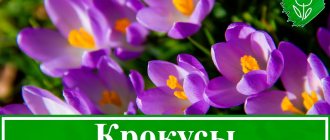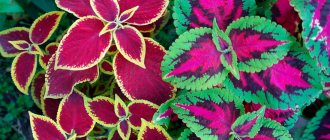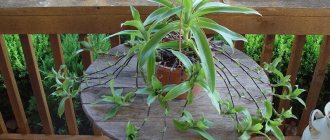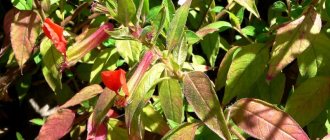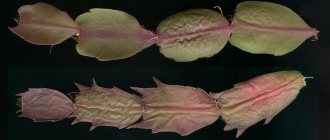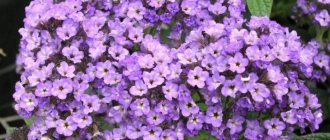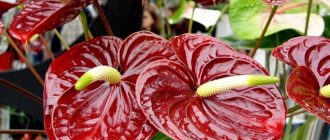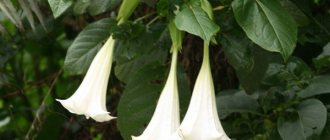From the photo of hypoestes you can see that this indoor plant differs from other flowers in its unique pink spots on the patterned leaves. The inflorescences of the crop are small and inconspicuous, so it is grown as an ornamental foliage plant.
Important! If the hypoestes does not receive the required amount of heat and light, the spots on the leaves will disappear and they will acquire a standard green color.
The natural habitat of the plants in question is considered to be the countries of southern Africa, as well as the subtropical zone of the island of Madagascar.
There are 150 types of such crops in nature, but no more than ten are grown at home. The plant goes well with various moisture-loving flowers and ornamental crops, including ferns.
Necessary conditions for growing a flower
- Hypoestes is a heat-loving plant, so it requires a temperature of +22-25 degrees. The seedling should be protected from sudden changes in temperature and drafts. When the temperature drops to +10 degrees, the hypoestes may die. In winter, the temperature in the room should not be lower than 18 degrees Celsius.
- Good lighting is responsible for the saturation of the color of the leaves.
And since this plant is tropical, it loves light, the main thing is not to place the pot in direct sunlight. It is recommended to install containers with hypoestes on the south side of the window sill. Lighting affects the development and growth of seedlings. However, in hot and sunny weather, the windows need to be shaded, thus protecting the seedlings from the sun. Otherwise, a burn may appear on the leaves and the plant will begin to turn yellow and wither. In winter, the bush needs light 14 hours a day. And since daylight hours become shorter during this period, you can buy an ultraviolet lamp. - Hypoestes requires a room with relatively high humidity to develop. If it is low in the room, then the flower can be placed next to the aquarium or a tray with additional liquid can be placed. In summer, the bush must be irrigated with warm water several times a day. It is better to do this either early in the morning or after sunset, this will help avoid burns on the leaves.
- In spring and summer, hypoestes must be fed with substances that include potassium. It will ensure durable coloring of the leaves of this shrub. You also need to apply nitrogen-containing fertilizers; if you add more or less fertilizer, light-colored spots may appear on the leaves.
Botanical description
The hypoestes plant has a soft, branched rhizome that grows horizontally in the upper, most fertile layer of soil. On fleshy, erect stems 30 to 60 cm high, the base of which becomes lignified and exposed over time, there are short-petiolate, ovate leaves 7-10 cm long with wavy edges and a pointed apex. The color of the leaves is unusual: spots of different shapes and color intensity appear on a dark purple or dark green background. From early summer to December, hypoestes blooms with tubular lilac flowers, collected on the tops of stems in semi-umbrellas or heads. The bracts of the hypoestes, hanging over the calyxes, have the shape of a bedspread. However, compared to the bright leaves, the plant's flowers do not look particularly attractive.
Proper watering
It is known that hypoestes has rather large leaves that evaporate a large amount of moisture .
And the plant simply needs moisture for life. Water the plant with water at room temperature and it should be soft. Under no circumstances should you overwater the plant; this can lead to the development of fungus and mold in the soil, as well as to the development of various diseases of the seedling.
Also, excess moisture in the soil leads to rotting of the root system of the flower , which all ends with the death of the bush.
- In summer, it is recommended to water the hypoestes 2-3 times a day or as the soil in the pot dries out.
- In autumn, as a rule, watering is reduced to once a day, and if the plant grows outside, then the rain will do it for you.
- With the onset of winter, watering the flower becomes even less frequent; the plant is irrigated once every 3 days.
Hypoestes flowering
The flowers are semi-umbrellas covered with bracts, which is what gave the flower its name (hypoestes literally means “under the house”). There can be from one to three buds located under the base of the bracts.
Flowering is not one of the main advantages of the crop, since it passes quickly, and its consequences are not very favorable. In addition to the fact that weed seeds quickly and regularly germinate in pots of a wide variety of flowers, the plant itself suffers. After flowering, it stretches out, becomes smaller in leaves, and loses its spotted decorative appearance. Its long, half-naked branches look very unattractive. The flowers themselves, falling off, produce a lot of debris.
Once the specimen is about to bud, the smartest solution is to remove the flower frog to avoid the “disaster” described above.
Trimming, pinching
As the hypoestes grows, the branches of the plant stretch out and spoil the appearance of the shrub. In this case, pruning will help. This should be done in spring or autumn.
- Trim protruding branches using a sharp knife or garden shears. In this case, weak or dead shoots can be removed.
- To renew the crown, it is necessary to completely remove its entire upper part; after some time it will grow back.
A distinctive feature of hypoestes is the rapid growth of new shoots in a short period of time.
In order for the bush to form correctly and have the desired shape, pinching is done . To do this, it is necessary to remove the upper buds of the plant and this will help accelerate the growth of lateral branches. As a result, the bush will become beautiful and acquire a lush shape.
Photo gallery
Like numerous tropical representatives of the acanthaceae family, the herbaceous plant is a perennial, distinguished by inconspicuous flowers; the opposite leaves have a narrow ovate shape.
How to care at home?
At home, hypoesthesia requires careful care, care and attention. Some gardeners grow the plant to decorate the interior with grown flowers. Hypoestes is a flowering plant; during this period it needs special care. Let us consider in more detail what needs to be done during the flowering and dormant periods of the flower.
- Flowering for this plant begins in summer and lasts quite a long time.
The inflorescences remain on the stem until December, which is unusual for many other flowers. With proper care, the bush is abundantly covered with small flowers that have a bright and delicate shade. However, experienced flower growers recommend removing the inflorescences; this will help preserve the hypoestesa’s strength before wintering. And the flowers fade quite quickly, dry out and fall off, but new inflorescences appear in this place. - There is no specific dormant period for this plant; each gardener chooses it independently.
The best time for this is immediately after the last flowers have faded. At this time, the plant is watered less frequently, fed, the necessary fertilizers are added, the optimal temperature is maintained and the length of daylight is limited. All this leads to a slowdown in growth and the stems practically do not stretch.
Common varieties
Codiaum: home care and methods of reproduction
Hypoestes has a sufficient number of species. Most of them are not suitable for growing at home. The following varieties are most often planted in pots on window sills.
Hypoestes Phyllostacha (leaf)
Hypoestes phyllostachya feels great if planted indoors. This species is also known as Hypoestes phylum. People call the flower “freckled face” because of the large number of specks on its leaves. The purple-red background color of the foliage, which looks very unusual, gives the plant a special decorative appearance.
Hypoestes can be grown both at home and outdoors
Interesting. Hypoestes phyllospica can be grown with equal success on a windowsill and in the garden (in relatively mild climatic conditions).
Hypoestes Mix
Hypoestes Mix is also called “Confetti”. It includes a large number of subvarieties, including:
- Red-raspberry;
- White;
- Crimson;
- Red wine.
From the name of the variety it becomes clear that the colors can be very different. Semi-lignified succulent stems and leaves with well-drawn veins are typical for Mixes. The length of the foliage, depending on the subspecies and growing conditions, can vary from 8 to 10 cm.
Hypoestes pink
Hypoestes rosea has another name - Pink Veil. This variety is considered fast-growing; it is often propagated from seeds at home. The foliage of this variety is characterized by the presence of a large number of soft pink spots on a bright green background. Since pink hypoestes has a compact size and rarely grows above 20 cm, it is often planted in apartments.
Features of growing outdoors
When growing hypoestes in open ground, you should adhere to the following rules:
- The plant should be planted in a well-lit place, but protected from direct sunlight and wind.
- Watering is done 2 times every 7 days. If it’s hot outside, water the seedling daily. The optimal time for this procedure is early morning or evening.
- Feed the bush every year. For this you can use mineral or organic fertilizers. They need to be applied once every 14 days. In autumn, the amount of fertilizer must be reduced, but not stopped, otherwise the leaves will begin to darken and dry out.
Hypoestes transplant
Produced every 2-3 years if the same specimen is grown. Many people prefer to replace the plant with a new one at the same frequency, especially since this does not present any difficulties or hassle. Replanting should not be combined with pruning, as this will be too stressful. Part of the earthen coma can be preserved and drainage must be provided.
Soil composition
Hypoestes does not make any great demands on the soil; any ready-made composition for flowering indoor crops is suitable for it. When preparing the substrate yourself, it is worth taking into account the desired pH level of 5-6 units. As components, you can take humus, high peat, leaf soil and add a little sand to them.
Photo
This is what an indoor flower looks like in the photo, which has been properly cared for:
Photo of a flower grown outdoors:
Features of reproduction
Hypoestes reproduces in several ways . Even a novice gardener can do this on his own at home. Hypoestes can be propagated using seeds or cuttings. Let's take a closer look at both methods.
Seeds
Seeds are bought in a specialized store or collected independently if you already have this plant at home. The seeds are very small, so you need to collect them very carefully so as not to lose the seed. Planting should be done in the spring, after the snow has completely melted and the earth has warmed up to the desired temperature. To do this, you need to prepare a container with the substrate in advance.
Step-by-step instructions for sowing seeds consists of the following steps:
- The prepared substrate needs to be watered a little.
- Place seeds in each container.
- Sprinkle a thin layer of soil on top.
- Cover the container with cellophane.
- Leave in a warm and well-lit place.
After 5-7 days the first shoots will appear. Remove the film after all the seeds have sprouted. In order for young shoots to develop fully, you need to monitor the temperature and lighting. After the seedlings grow, they need to be planted in separate pots.
Cuttings
An equally common method of propagating hypoestes is the cutting method. To do this, you need to perform the following steps:
- Cut the cuttings obliquely, the length of which should not exceed 10 centimeters.
- Place the cut in water and leave for several hours. This is necessary so that the cutting is filled with moisture and then it will more easily endure this procedure.
- Place covering material on top of the container with cuttings.
- Place in a warm place out of direct sunlight. The temperature during rooting of cuttings should not be lower than +20 degrees.
- After following all the rules, the cuttings are placed in the prepared soil and left until the first shoots of the root system appear.
- Next, the seedling is pinched so that a beautiful crown is formed.
- After transplanting the cuttings, you need to cover them with cellophane on top and thus create a greenhouse effect.
Until the first leaves appear, the seedling should be moistened abundantly and the soil should not be allowed to dry out completely. Only by the presence of leaves can one judge the successful propagation of hypoestes. After this, the film must be removed and the seedling must be cared for as for an adult shrub, and not for seedlings.
Possible problems and illnesses
Health problems in hypoestes arise from improper agrotechnical care. Periodically exposed to the development of the following diseases:
- Powdery mildew.
- Gray rot.
- Fusarium.
In case of minor pest infestation, it is recommended to spray the plant with special means aimed at combating these insects. If the affected area is large, then you will have to get rid of the bush; in extreme cases, it will die.
In addition to diseases, hypoestes can be attacked by pests:
- Aphid.
- Mealybug.
- Spider mite.
- Whitefly.
If pests are detected, the seedling must be treated with insecticides, and if the insects do not disappear, then treatment must be continued for 7 days, the procedure must be carried out daily.
Hypoestes was loved primarily for its bright and large leaves and only then for its flowering. If you always follow the rules of care, the plant will grow healthy, beautiful, lush and will delight you with its beauty and compactness for a long time. The abundance of hypoestes varieties allows you to decorate your garden plot in a variety of colors.
Cuttings
Cuttings take root easily and quickly. Can be rooted in water or soil with the addition of peat at a temperature not lower than +20°.
With proper care, hypoestes is practically not damaged by pests.
If this does happen, the plant is treated with insecticides in accordance with the instructions on the packaging.
Hypoestes in the interior
The modern diversity of cultural forms comes from two closely related species growing in Madagascar
Blood-red Hypoestes (Hypoestes sanguinolenta Hook)
The leaves are up to 8 cm long, oval, pointed, with spots of various shades of red and bright red veins.
Hypoestes phylostachya Baker
The color is red, with a purple tint.
There are many hybrids of this variety of hypoestas. The most popular are Splash Red - with large pink spots on the leaves, Splash Pink - with pink leaves and green veins and spots, and Splash White , which has white leaves with green veins.
Hypoestes Splash Red
Hypoestes Splash Select Pink
Hypoestes Splash White
Hypoestes is an ideal plant for beginning gardeners and those who want to create a stylish and cozy interior.
Hypoestes
Share link:
Rate the article!
[Total: 0 Average: 0]
